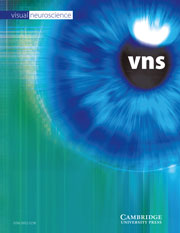Crossref Citations
This article has been cited by the following publications. This list is generated based on data provided by
Crossref.
Ayoub, George S.
and
Matthews, Gary
1992.
Substance P modulates calcium current in retinal bipolar neurons.
Visual Neuroscience,
Vol. 8,
Issue. 6,
p.
539.
Fontanesi, Gigliola
Traina, Giovanna
and
Bagnoli, Paola
1993.
Somatostatin-like immunoreactivity in the pigeon visual system: Developmental expression and effects of retina removal.
Visual Neuroscience,
Vol. 10,
Issue. 2,
p.
271.
Traina, Giovanna
Fontanesi, Gigliola
and
Bagnoli, Paola
1994.
Maturation of somatostatin immunoreactivity in the pigeon retina: Morphological characterization and quantitative analysis.
Visual Neuroscience,
Vol. 11,
Issue. 1,
p.
165.
Kyle, Ann L.
Luo, Bao-guo
Magnus, T. H.
and
Stell, W. K.
1995.
Substance P-, F8Famide-, and A18Famide-like immunoreactivity in the nervus terminalis and retina of the goldfish Carassius auratus.
Cell and Tissue Research,
Vol. 280,
Issue. 3,
p.
605.
Katz, Paul S.
and
Frost, William N.
1996.
Intrinsic neuromodulation: altering neuronal circuits from within.
Trends in Neurosciences,
Vol. 19,
Issue. 2,
p.
54.
Djamgoz, Mustafa B.A.
Evans-Capp, Alison J.
and
Wagner, Hans-Joachim
1996.
Intra-vitreal injection of substance P antibodies as an antagonist in the vertebrate (fish) retina.
Journal of Neuroscience Methods,
Vol. 64,
Issue. 2,
p.
237.
Wagner, H.-J.
Fröhlich, E.
Negishi, K.
and
Collin, S.P.
1998.
The eyes of deep-sea fish II. Functional morphology of the retina.
Progress in Retinal and Eye Research,
Vol. 17,
Issue. 4,
p.
637.
Yazulla, Stephen
and
Studholme, Keith M.
2001.
Neurochemical anatomy of the zebrafish retina as determined by immunocytochemistry.
Journal of Neurocytology,
Vol. 30,
Issue. 7,
p.
551.
Yazulla, Stephen
and
Studholme, Keith M.
2002.
Chemical Anatomy of the Zebrafish Retina.
p.
3.
Djupsund , Kaj
Furukawa , Tetsuo
Yasui , Syozo
and
Yamada , Masahiro
2003.
Asymmetric Temporal Properties in the Receptive Field of Retinal Transient Amacrine Cells .
The Journal of General Physiology,
Vol. 122,
Issue. 4,
p.
445.
Sakamoto, Tatsuya
Fujimoto, Masaaki
and
Ando, Masaaki
2003.
Vol. 225,
Issue. ,
p.
91.
Repérant, J.
Ward, R.
Miceli, D.
Rio, J.P.
Médina, M.
Kenigfest, N.B.
and
Vesselkin, N.P.
2006.
The centrifugal visual system of vertebrates: A comparative analysis of its functional anatomical organization.
Brain Research Reviews,
Vol. 52,
Issue. 1,
p.
1.
Kalloniatis, Michael
Loh, Chee Seang
Acosta, Monica L
Tomisich, Guido
Zhu, Yuan
Nivison‐smith, Lisa
Fletcher, Erica L
Chua, Jacqueline
Sun, Daniel
and
Arunthavasothy, Niru
2013.
Retinal amino acid neurochemistry in health and disease.
Clinical and Experimental Optometry,
Vol. 96,
Issue. 3,
p.
310.

